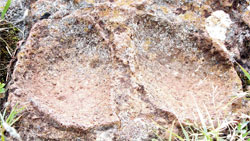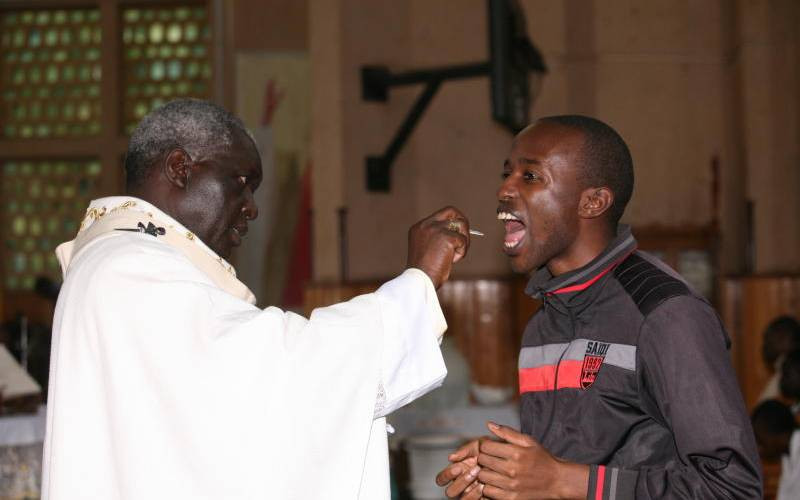By Michael Oriedo
Mt Elgon District readily evokes images of a ragtag army and sounds of gunshots.
About two years ago, the area was a battleground between Kenya military forces and the Sabaot Land Defence Force, a militia group, that claimed to spearhead fair allocation of land to local communities.
But unknown to many people, the hilly district is endowed with amazing tourist features that are unexplored.
 |
| Teachers and students from Chelebei Secondary School in one of the caves |
 |
Locals claim "Jesus" left these footprints. Photos: Michael Oriedo/Standard |
We set out on an expedition to sample these features. Our first stop was at a boulder, which has footmarks that residents claim belong to Jesus Christ.
According to our guide, Timothy Chesebe, residents believe "Jesus" walked on the boulder, leaving the footprints.
"He came, sat here and stepped on this point," claims Mr Chesebe pointing at the bow-like depressions and footprints.
Adjacent to the footprints are two other depressions, which he adds are knee marks Jesus left when he knelt on the spot to pray.
"We believe that he prayed at this rock and that is why this area is fertile," he says.
Mt Elgon is one of the areas where crops are planted all the year round.
Although geologists may have an explanation for the fertile soils, residents believe in the myth. They have passed the story from generation to generation. "I first visited this place with my grandfather as a young boy," says Chesebe.
"Then the marks were clear. One could even see the thumb prints but these have now weathered."
Holy ground
He says that though the rock is believed to be a "holy ground", it has no religious significance to residents.
Stay informed. Subscribe to our newsletter
"Nobody comes here to pray. Occasionally, students come to see the marks but stopped during the fighting. This place may soon be forgotten," he says.
From the rock, our guide takes us to view an underground river called Malakisi. It originates from the slopes of Mt Elgon and flows through Bungoma to the neighbouring Uganda.
According to Sida (Swedish International Development Cooperation Agency), which is undertaking a water project in the region, the river meets River Lwakhakha near Tororo, Uganda to form River Malaba, which then flows into Lake Kyoga.
From its source, River Malakisi flows on land until it reaches a spot where it disappears into the ground only to emerge about half a kilometre away. The point where the river disappears is a spectacle to behold. It flows menacingly on its course only to vanish between rocks.
One can hear the forceful waters flowing under the ground. Residents have christened the place daraja ya mungu (God’s bridge).
"We call it daraja ya mungu because to us it is a natural bridge. We can pass comfortably without the risk of falling in the river," says Chesebe.
The river is the main source of water for Bungoma residents. Studies by Sida show that intensive settlement and human encroachment along the river have resulted in pollution.
Despite that, the underground stream remains a favourite spot for the few visitors in the area.
Water fall
Another exciting feature is a 40m waterfall. Though obscured by thick vegetation of wild shrubs as a result of neglect, the natural feature located in Kopsiro division is a sight to behold.
From far, the waterfall appears like a strip of snow suspended within green vegetation. It is situated along the course of River Kuywa, which joins River Malakisi.
According to our guide, the waterfall is the most toured place by locals and visitors.
"Most of those who tour the site are students and their teachers from the neighbouring schools," he says.
It is common to see residents taking pictures at the site. However, the thick vegetation surrounding the waterfall makes it impossible for one to see its full length.
Breath taking
Two hills from the waterfall are gigantic caves. The caves stretch for about 100m.
According to Chesebe, no one knows how the caves came about.
"Our forefathers found them and lived there before building modern houses," he says.
The caves came in handy during the security operation andwhen violence broke out in 2007. Those displaced by the fighting went to hide in them
During our excursion, we met a teacher and a group of students.
"I brought my students to these caves to teach them about geographical features and different types of rocks," says Mr Mathews Sumba of Chelebei Secondary School.
Sumba says teaching geography is easier for him since most of the physical features students learn theoretically are just a distance away.
The modes of transport are mainly motorbikes and donkeys. When it rains, which is quiet often, the roads become impassable.
Visitors must be prepared to walk across the undulating terrain to reach these breath-taking features.
However, the walk is worth the gratification derived from the majestic views of the Elgon.
 The Standard Group Plc is a
multi-media organization with investments in media platforms spanning newspaper
print operations, television, radio broadcasting, digital and online services. The
Standard Group is recognized as a leading multi-media house in Kenya with a key
influence in matters of national and international interest.
The Standard Group Plc is a
multi-media organization with investments in media platforms spanning newspaper
print operations, television, radio broadcasting, digital and online services. The
Standard Group is recognized as a leading multi-media house in Kenya with a key
influence in matters of national and international interest.
 The Standard Group Plc is a
multi-media organization with investments in media platforms spanning newspaper
print operations, television, radio broadcasting, digital and online services. The
Standard Group is recognized as a leading multi-media house in Kenya with a key
influence in matters of national and international interest.
The Standard Group Plc is a
multi-media organization with investments in media platforms spanning newspaper
print operations, television, radio broadcasting, digital and online services. The
Standard Group is recognized as a leading multi-media house in Kenya with a key
influence in matters of national and international interest.











